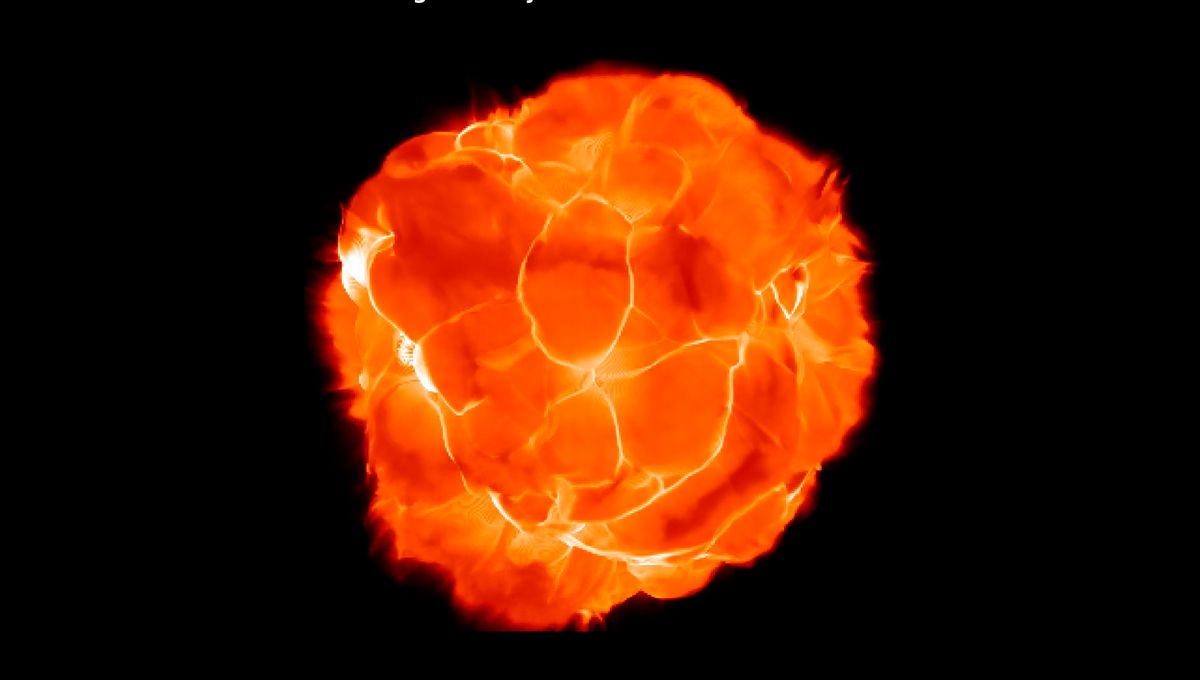
A new simulation challenges the way we picture one of the most famous stars in the night sky. Betelgeuse is among the top 20 brightest stars (although occasionally it is not) and is a red supergiant, the final stage of stellar evolution leading into a supernova. We usually picture stars as big plasma balls – but a new simulation shows that when we get to the red supergiants, that view is not correct.
Betelgeuse is enormous compared to the Sun. Its radius is at least 640 times the solar radius but might get to a bit over 1,000 times – If placed in the solar system, it would stretch past the orbit of Jupiter. A few hundred million suns would fit in that volume, but it has a mass of about 15 suns, which suggests an extremely low density in the outer layers.
Betelgeuse is around 500 light-years away from us, close enough in cosmic terms that we can see features on its surface. Those features could suggest two things: Either that the star is rapidly rotating, or that its surface is rapidly changing. Both are valid and possible, but each requires something more. If rotation is correct, then that something extra is cannibalism.
“Most stars are just tiny points of light in the night sky. Betelgeuse is so incredibly large and nearby that, with the very best telescopes, it is one of the very few stars where we actually observe and study its boiling surface. It still feels a bit like a Science Fiction movie, as if we have traveled there to see it up close,” study coauthor Selma de Mink, director at the Max Planck Institute for Astrophysics, said in a statement. “And the results are so exciting. If Betelgeuse is rapidly rotating after all, then we think it must have been spun up after eating a small companion star that was orbiting it.”
The other interpretation is that convection – just like the boiling water in a pasta pot – creates bubbles of plasma as large as Earth’s entire orbit that come up and go down extremely fast. The surface of red supergiants should be changing constantly, but in the simulated scenarios, the bubbles need to move at about 30 kilometers (19 miles) per second. The simulations suggest that the boiling plasma scenario can explain the apparent fast rotation of the star in about 90 percent of modeled scenarios. More data is necessary to understand if this is indeed the case.
Some of the data collected by the ALMA (Atacama Large Millimeter/submillimeter Array) in 2022 is now being analyzed to help provide more clarity. The simulations also allow prediction about future observations and that’s intriguing. Currently, Betelgeuse is dimming again, likely one of its periodic changes in brightness.
“There is so much we still don’t understand about gigantic boiling stars like Betelgeuse,” added co-author Andrea Chiavassa, an astronomer at CNRS. “How do they really work? How do they lose mass? What molecules can form in their outflows? Why did Betelgeuse suddenly get less bright? We are working very hard to make our computer simulations better and better, but we really need the incredible data from telescopes like ALMA.”
The paper reporting the findings is published in The Astrophysical Journal Letters.
Source Link: Newly Released Betelgeuse Simulation Shows It As A Boiling, Bubbling Ball